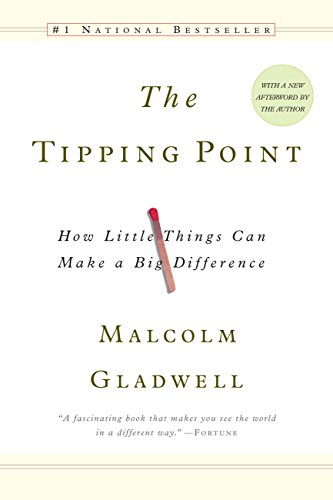

This article is an excerpt from the Shortform summary of "The Tipping Point" by Malcolm Gladwell. Shortform has the world's best summaries of books you should be reading.
Like this article? Sign up for a free trial here .
Who are connectors, mavens, and salesmen? Where do these distinctions come from, and how are these three types of people crucial to the spread of ideas and important for business?
Connectors are sociable, gregarious, and naturally skilled at making friends and acquaintances. Mavens are endlessly curious and adept at gathering and retaining information on a wide variety of topics. Salesmen are the people who pitch the idea or message behind an epidemic and persuade people to jump on board. The terms comes from Malcolm Gladwell’s The Tipping Point.
We’ll cover the role of connectors, mavens, and salesmen in business and why all three are crucial to the spread of ideas, services, and products.
Connectors, Mavens, and Salesmen
How do you spark a trend that spreads like wildfire, or turn a product into the latest must-have item? You create a social epidemic. The Tipping Point explains how social epidemics — spreading ideas, messages, behaviors, and products — function like viruses, growing gradually until they reach a critical mass (the tipping point) and explode.
Three factors can be adjusted to tip an idea to a social epidemic: the messenger, the message itself, or the context of the message.
The Law of the Few
When you’re trying to spread a message, idea, or product to epidemic proportions, you need people to help preach your message and spread the word to the masses. The Law of the Few proposes that there are certain, special types of people who are much more effective at broadcasting your idea and getting people to listen and follow suit. These special people are exceptional either in their social connections, knowledge, or persuasiveness and fall into three personality types: Connectors, Mavens, and Salesmen.
Connectors: Social Butterflies
Who are connectors, mavens, and salesmen? Connectors seem to know everyone. You can find Connectors in every walk of life; they are sociable, gregarious, and are naturally skilled at making — and keeping in contact with — friends and acquaintances.
Connectors tend to be connected to many communities — whether through interests and hobbies, jobs that cause them to work with people in other fields, or other experiences. Their strength is in occupying many different worlds, and bringing them together.
However, Connectors are not close with all their connections. In fact, Connectors’ power is in having lots of acquaintances, or “weak ties.” Your acquaintances typically have different social circles and communities — exposing them to different people and information — than you, whereas your friends’ knowledge and social ties tend to largely overlap with your own. Thus, your friends can help spread a message in the same communities you occupy, but weak ties can help spread that message beyond your reach because they belong to different worlds than you do.
For this reason, weak ties are more valuable than close friends in creating a wider reach for spreading epidemics, and Connectors are the hubs at the center of all those worlds.
Mavens: Data Banks
Let’s look at the second type of influencer among connectors, mavens, and salesmen. While Connectors are people specialists who know many people and can spread information widely, Mavens, on the other hand, are information specialists; they are endlessly curious and adept at gathering and retaining information on a wide variety of (sometimes obscure) topics.
A Maven’s influence is in the power of her recommendation. People know that Mavens are knowledgeable and trustworthy sources of information, so a Maven’s word carries a lot of weight. If a Maven suggests you check out a budding epidemic, you’re inclined to listen.
Mavens also love to share their knowledge with other people, and are socially motivated to help people with the information they’ve gathered: A Maven is the kind of person who not only clips coupons and knows when a store is having a sale, but also shares coupons with her friends.
Mavens’ genuine helpfulness inspires more trust and credibility — people know Mavens have no agenda or ulterior motive — so when they give recommendations people tend to take them more seriously. In a social epidemic, they serve as data banks — they carry the message, with authoritativeness.
Salesmen: Persuaders
The third person in the list of connectors, mavens, and salesmen often gets the credit. Salesmen are the people who pitch the idea or message behind an epidemic and persuade people to jump on board. They do not merely store and share information; Salesmen want to convince you to follow their advice.
Salesmen have the right words plus an inherent energy, enthusiasm, charm, and likability that makes people want to listen to them. Plus, Salesmen instinctively know how to use nonverbal cues to reinforce their power of persuasion.
Nonverbal communication — including facial expressions, tone of voice, eye contact, and body language — have a powerful impact on us, even when they are so subtle that we don’t notice them. People naturally fall into a conversational rhythm when they talk, subconsciously matching speech cadence, tone, and volume. The better your conversational harmony with someone, the more connected you feel to them.
Salesmen are masters at not only matching conversational rhythms, but drawing people into their own rhythms and setting the tone for the interaction. This natural ability makes Salesmen particularly skillful at influencing people’s emotions and thus persuading them to join a movement.
Employing the Law of the Few and Connectors, Mavens, and Salesmen
As Gladwell illustrates with his varied examples of connectors, mavens, and salesmen, social epidemics take many forms — from fashion crazes to rumors to crime waves — and each calls for a unique combination and application of the three principles he discusses. Not every principle will be applicable to a given epidemic, and similarly, not every messenger will be effective. The key is to understand how these strategies can be employed so that you can determine what’s most effective in your situation.
(Shortform note: Overall, the book doesn’t offer much — if any — general tips for applying of these strategies, presumably because each situation is so unique. Instead, Gladwell focuses on driving home understanding of the principles based on research, his explanations, and case studies.)
———End of Preview———

Like what you just read? Read the rest of the world's best summary of "The Tipping Point" at Shortform . Learn the book's critical concepts in 20 minutes or less .
Here's what you'll find in our full Tipping Point summary :
- What makes some movements tip into social epidemics
- The 3 key types of people you need on your side
- How to cause tipping points in business and life






